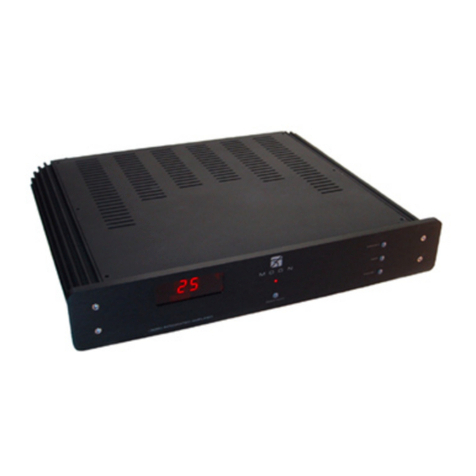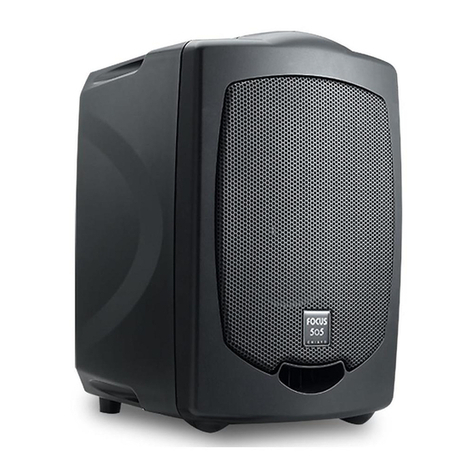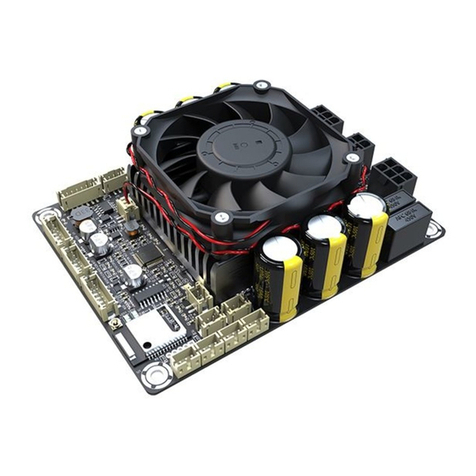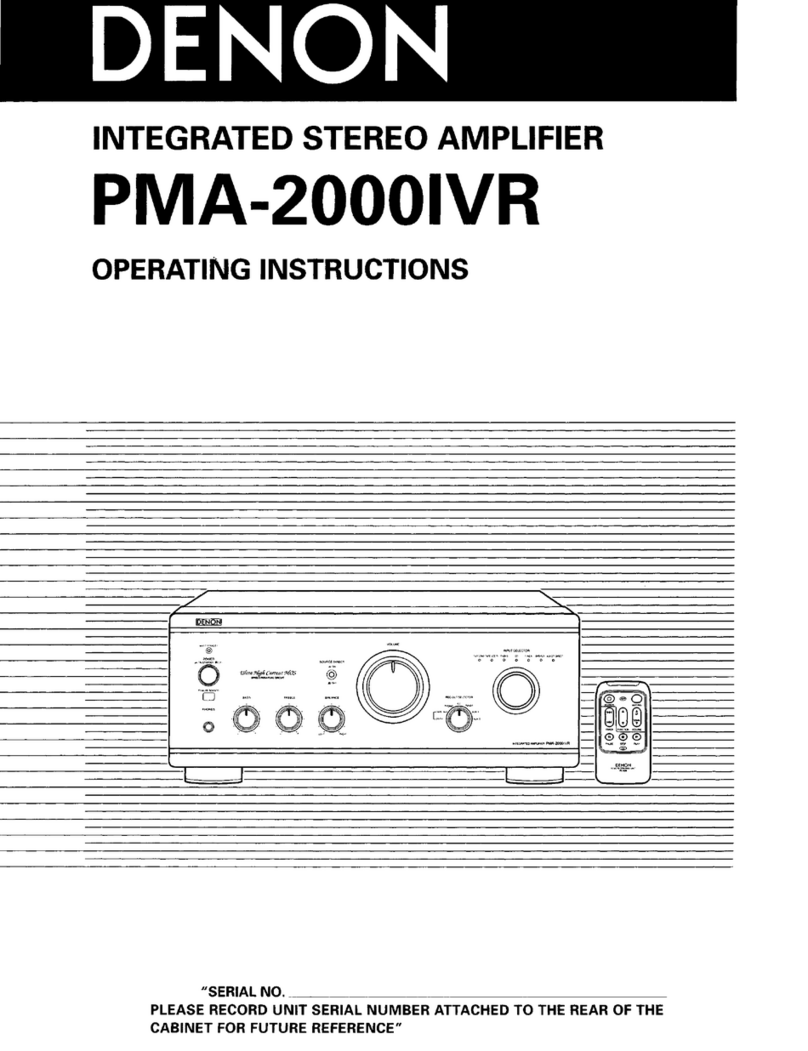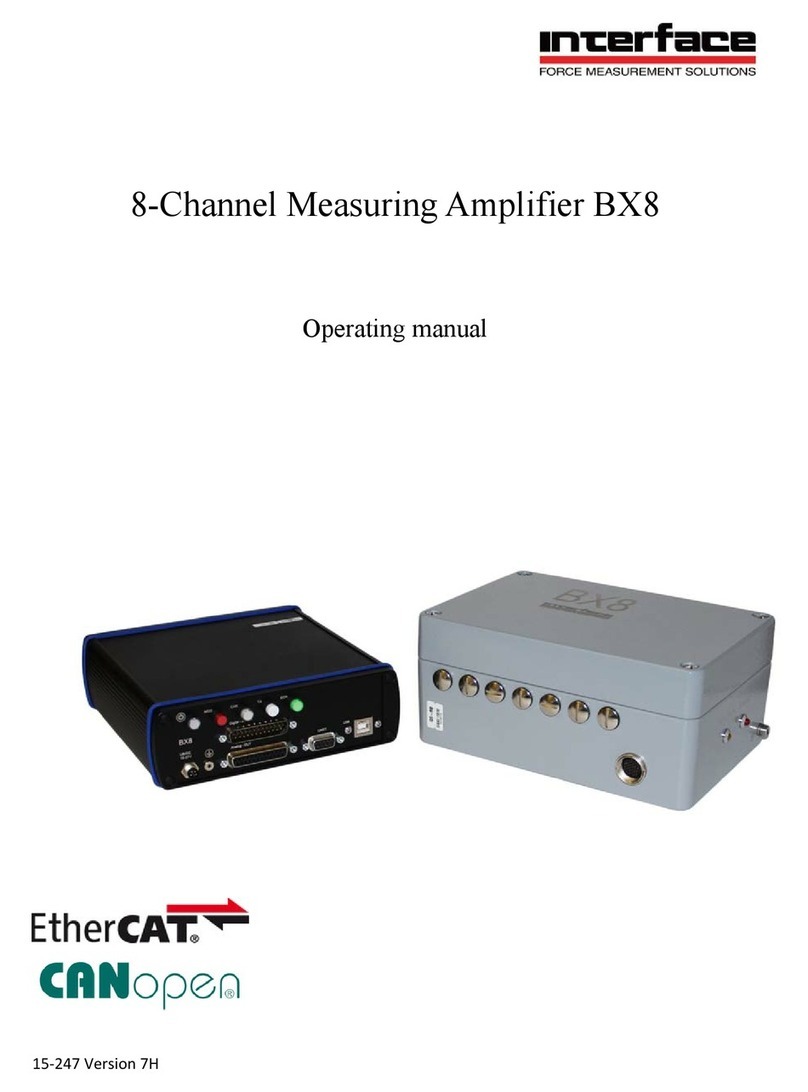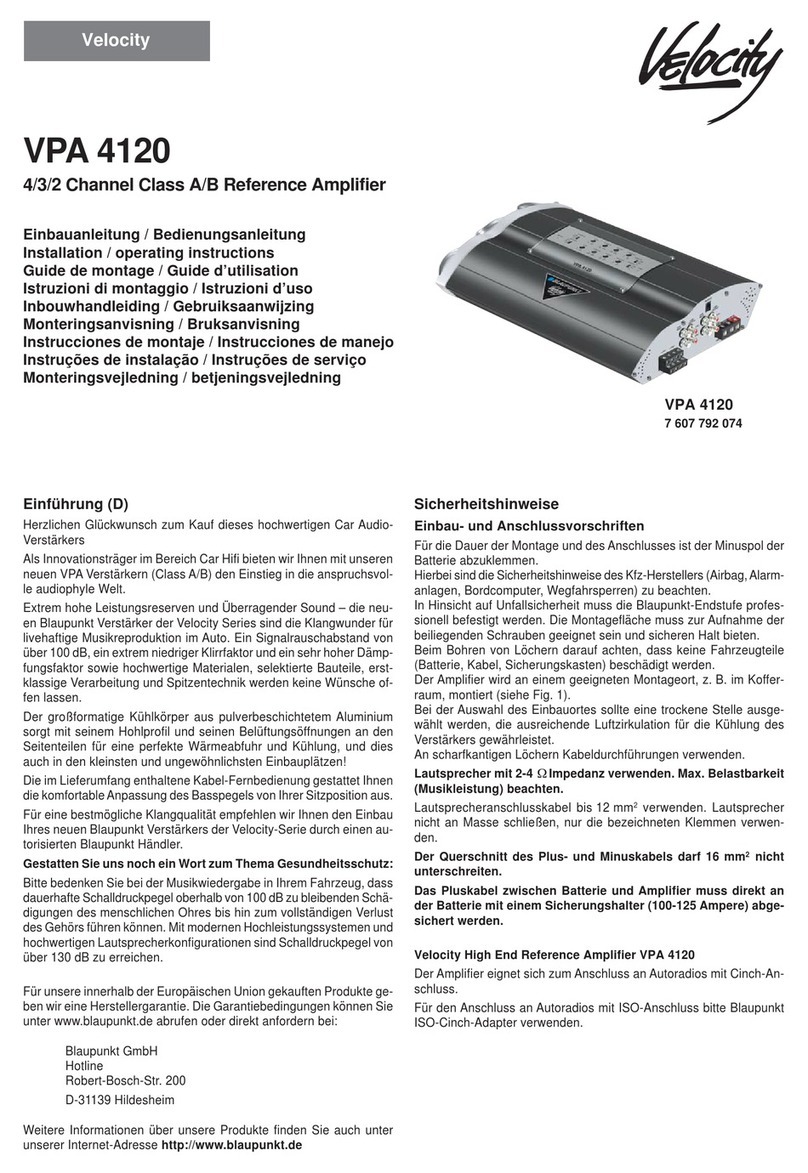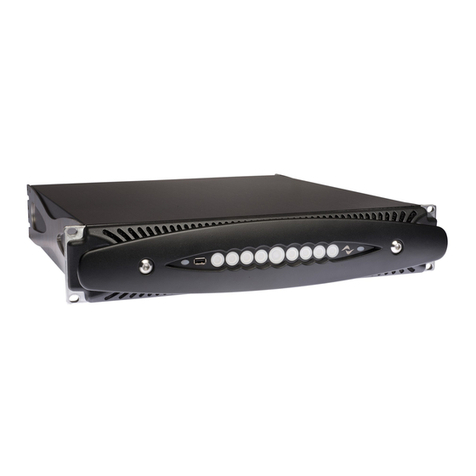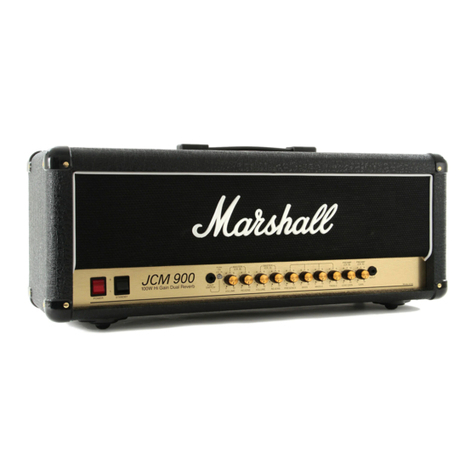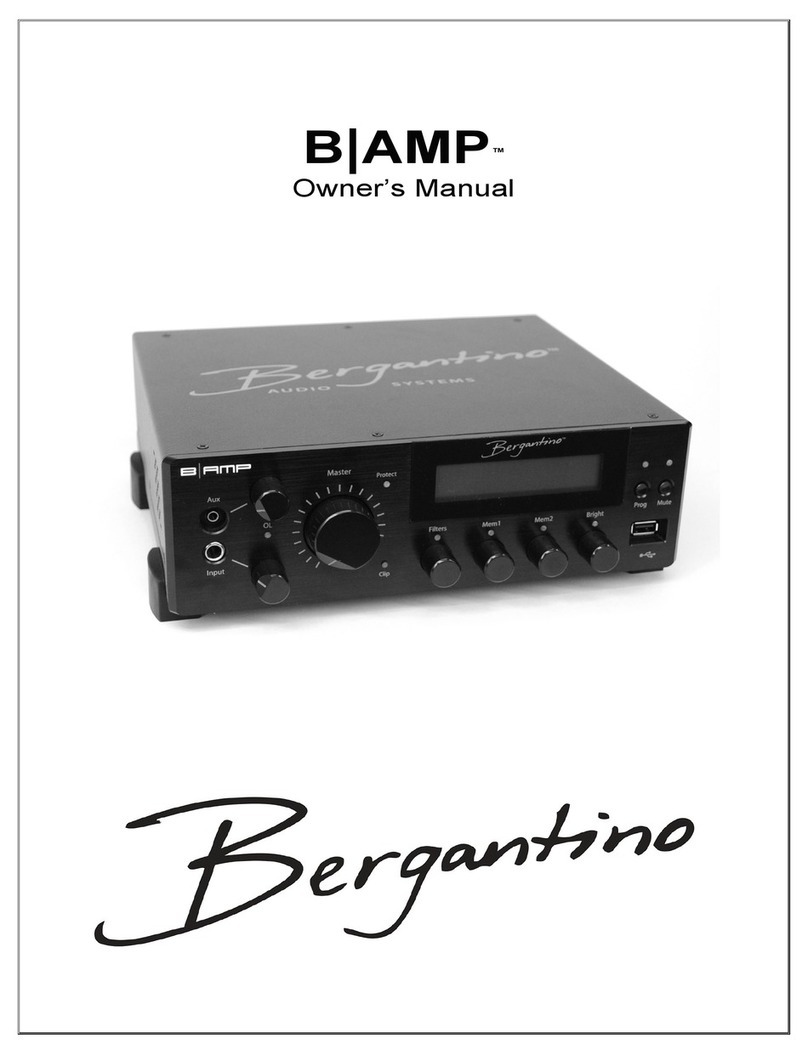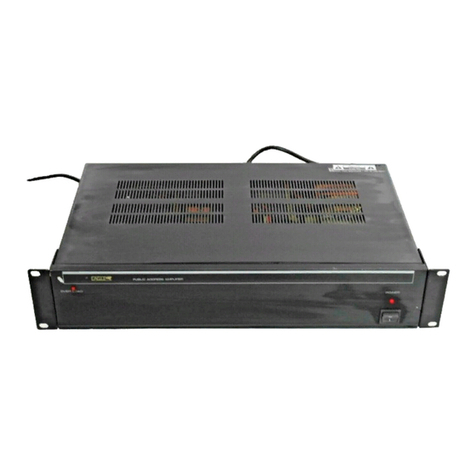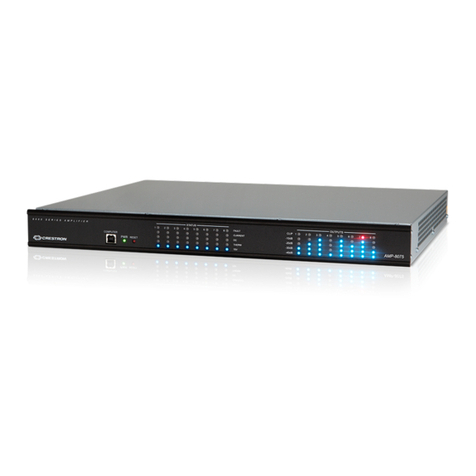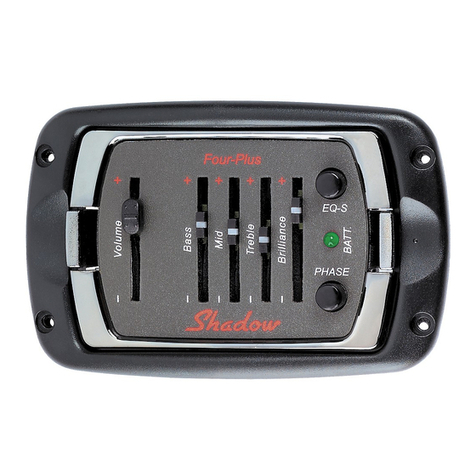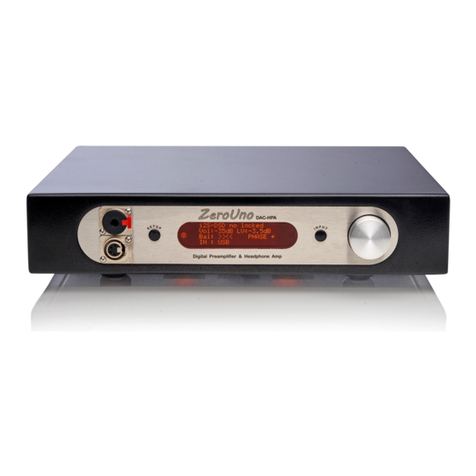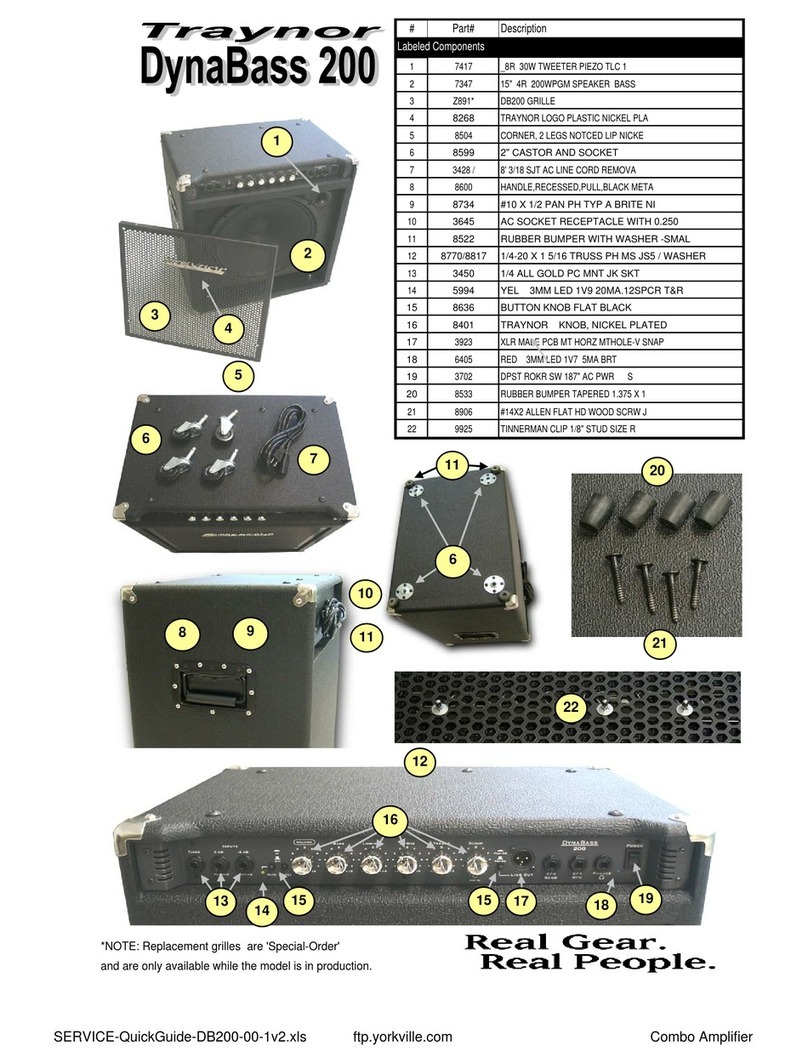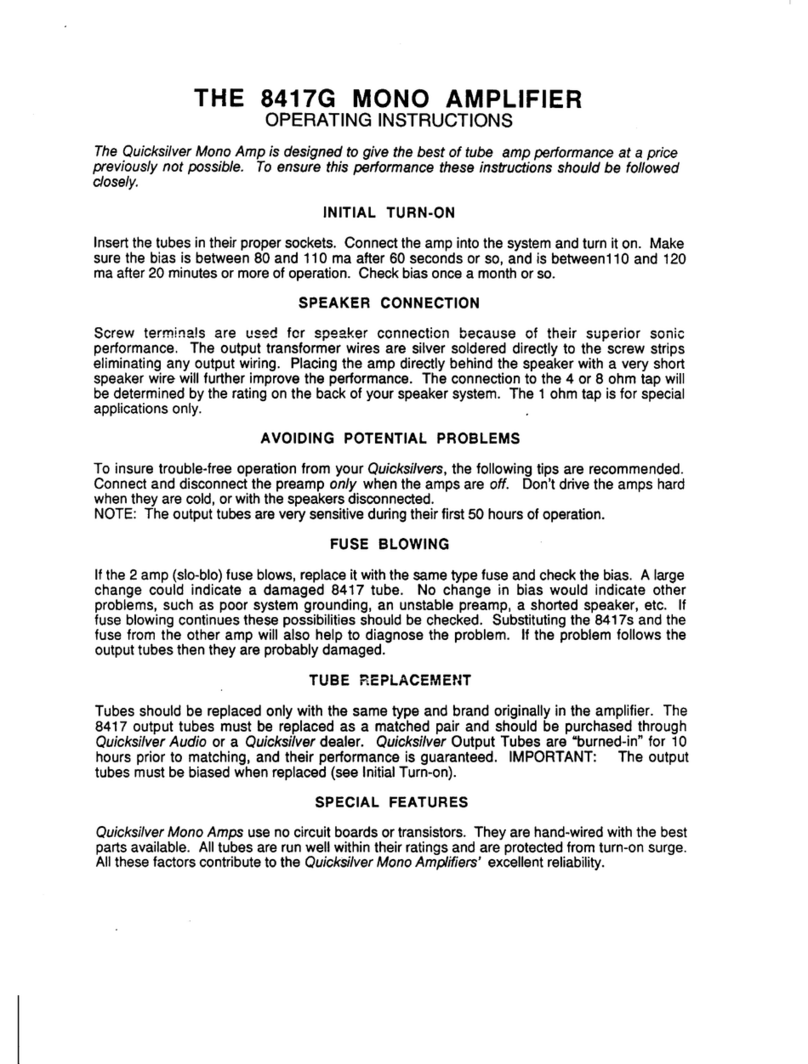Greg Hanks Design BA-660 Operation manual

GREG HANKS DESIGN
BA-660
Operation and Service Manual
Issue
1

CONSCIENTIOUS AUDIO DESIGN AND MANUFACTURE
Use and Care of your Mic Pre/limiter
Greg Hanks Design
35 Hardscrabble Hill Rd.
Chappaqua, New York 10514-3009
(914) 238-4172 FAX (914) 242-0282


BA660.doc 01/01/97 iof 25
Table of Contents
TABLE OF CONTENTS .....................................I
SUGGESTIONS FOR SAFETY ......................... 2
SPECIFICATIONS.............................................. 3
Gain:.............................................................. 3
Input Impedance (20 Hz - 20 Khz) ................. 3
Frequency Response...................................... 3
S/N Ratio ....................................................... 3
Output Impedance ......................................... 3
Phantom Voltage nom. +48VDC (Internally
adjustable to +300 VDC @ 5 ma.).................. 3
Attack Time - 200µs to 150 ms....................... 3
Release Time - 15 ms - 6 sec.......................... 3
Ratio range..................................................... 3
Range of limiting........................................... 3
Maximum Input Level................................... 3
Maximum output level................................... 3
Harmonic Distortion...................................... 3
IM Distortion................................................. 3
Pin conventions:............................................ 3
OVERVIEW I/O CONNECTIONS.................... 6
MIC In............................................................ 6
Line In............................................................ 6
Insert Send ..................................................... 6
Insert Return .................................................. 8
Side chain input.............................................. 8
Side Chain Couple.......................................... 8
Line Output .................................................... 8
Chassis Gnd (Green Post)............................... 8
Signal Gnd ..................................................... 8
Power Input.................................................... 9
CONTROLS: FRONT PANEL........................ 9
+48 V ............................................................10
Input Selector ...............................................10
Input overload LED......................................10
Insert Bypass.................................................10
Input trim......................................................10
Phase reverse................................................10
Meter zero.....................................................11
Limiter Tip In...............................................11
Input meter select..........................................11
Gain Reduction bypass..................................11
Preset/Manual...............................................11
Threshold ......................................................11
Gain Cell Clip...............................................12
Attack Time ...................................................12
Release Time.................................................12
Ratio .............................................................12
Output gain ...................................................12
Power switch .................................................13
OVERVIEW OF OPERATION.........................13
INSTALLATION CONSIDERATIONS............15
Shields and signal grounding ..........................15
Rear Panel Ground connections......................16
Input and Output balance................................16
THEORY OF OPERATION..............................17
SUMMARY OF HOW TO FOLLOW THE
DIAGRAMS. .............................................18
Basic tube operation......................................18
Gain Settings.................................................18
System Gain Structure Control ......................19
Insert Sends and Returns ...............................19
Level Meter ...................................................19
Gain Cell.......................................................20
Gain Cell Control..........................................21
PRESETS.......................................................21
Output Stage..................................................21
WARRANTY......................................................22

BA660.doc 01/01/97 2of 25
WATER AND MOISTURE -- Do not use
the unit near any source of water or in
excessively moist environments
OBJECT AND LIQUID ENTRY - - Care
should be taken so that objects do not
fall and liquids are not spilled into the
enclosure through openings
VENTILATION - - When installing the unit
in a rack or any other location, be sure
there is adequate ventilation..
HEAT - -The unit should be situated away
from heat sources such as radiators,
heat registers, stoves or other units
that produce heat.
POWER SOURCES - - Care must be taken
to ensure that the unit is only
connected for voltage that is selected
via the internal selector(s).
POWER CORD PROTECTION - - AC
power supply cords should be routed
so that they are not likely to be walked
on or pinched by items placed upon
or against them, paying particular
attention to cords at plugs,
convenience receptacles and the point
where they exit from the unit. Never
take hold of the plug or cord of your
hand is wet and always grasp the plug
body when connecting or
disconnecting it.
GROUNDING OF THE PLUG - - This unit
is equipped with a 3-wire grounding
type plug, a plug having a third
(grounding) pin. This plug will only
fit into a grounding type poweroutlet.
This is a safety feature. If you are
unable to insert the plug into the
outlet, contact your electrician to
replace your 2 pin receptacle. Do not
defeat the purpose of this grounding-
type plug by removing the grounding
pin.
CARTS AND STANDS - - The unit is heavy,
and made with delicate components
and as such should only be used with
racks and stands recommended by the
manufacturer. The unit and cart
combination should be moved with
care. Quick stops, excessive force and
uneven surfaces may cause the unit
and cart combination to overturn.
WALL OR CEILING MOUNTING. - - The
unit should be mounted to a wall or
ceiling only as recommended by the
manual.
CLEANING - - The unit should be cleaned
only as recommended by the
manufacturer.
NON USE PERIODS - - The AC power
supply cord should be removed from
the unit when left unused for a long
period of time.
DAMAGE REQUIRING SERVICE - -The unit
should be serviced by qualified service
personnel when;
A) The AC Power supply cord or the
plug has been damaged; or
B) Objects have fallen into the unit;
or
C) The unit has been exposed to rain
or liquids have been spilled into
the unit or
D) The unit has been exposed to
thermonuclear explosion; or
Suggestions for Safety

BA660.doc 01/01/97 3of 25
E) The unit does not appear to
operate normally or exhibitsA
marked change in performance; or
F) The unit has been dropped or
the enclosure exhibits
significant damage.
Specifications
• Gain:
Mic In
>+97 db max.
<-20 db min.
Line In
> +34 db max.
< -10 db min.
• Input Impedance (20 Hz - 20 Khz)
Mic = 1k3 Ω
Line > 20K Ω
Insert Return > 100 K Ω
Side Chain Insert > 220KΩ
• Frequency Response
Mic In - 6 Hz - 60 Khz +0, -3
Line In -6 Hz ->60 Khz+0/-1
•• S/N Ratio
> 120 db
•• Output Impedance
Line Out (20-20Khz)
100 Ωbalanced
50 Ωunbalanced
Insert Send < 100 Ω
• Phantom Voltage nom. +48VDC
(Internally adjustable to +300 VDC @
5 ma.)
• Attack Time - 200µs to 150 ms
• Release Time - 15 ms - 6 sec
• Ratio range
1.2:1 - > 20:1
• Range of limiting
≥18db
• Maximum Input Level
Mic In
@ +14 > + 45 dbm
@ -15 > +25 dbm
Line In > +40 dbm
• Maximum output level
> +34 dbv ref. 600 Ω into
150 Ω
• Harmonic Distortion
< .6% at all levels up to +34
dbm
• IM Distortion
< .1% at all levels up to +34
dbm
• Pin conventions:
XLR connectors are wired as
follows;
Pin 1 = Shield
Pin 2 = Signal Plus +
Pin 3 = Signal Minus -
All 1/4" connections are TRS,
and are wired as follows;

BA660.doc 01/01/97 4of 25
Tip = Signal Plus +
Ring = Signal Minus - Sleeve = Shield/Chassis
…CUT TO THE CHASE…!!…CUT TO THE CHASE…!!
Microphone use
• Plug the mic into the unit
• Set the input selector to -45
• Monitor the input, (Push monitor select button "IN")
• Set the input selector and trim so that the average signal is around the yellow
led.
• Set the Threshold control for desired limiting.
• Set the attack, release and ratio controls to 12:00
• Monitor the output signal, (Put the monitor select button in the "Out"
position)
• Set the output gain makeup control for around the yellow LED.
Line level use
• Plug the Line level signal into the input of the BA-660.
• Set the monitor selector switch to the input (in) position
• Set the input selector and trim controls so that the signal is lighting the the
Yellow on the peaks.
• Set the input selector and trim so that the average signal is around the yellow
led.
• Set the Threshold control for desired limiting.
• Set the attack, release and ratio controls to 12:00
• Monitor the output signal, (Put the monitor select button in the "Out"
position)
• Set the output gain makeup control for around the yellow LED.

BA660.doc 01/01/97 5of 25
This page intentionally left blank--

BA660.doc 01/01/97 6of 25
Overview I/O Connections
• MIC In
Accepts low impedance balanced
signals between -70 and +14
Nominal level. Phantom power is
provided via the front panel +48V
switch. Internal provisions are
available for phantom voltages up
to +300 VDC. Shield is carried to
Pin 1 via the power ground
internally for phantom purposes.
The shield connection of the XLR
is made via the chassis connection
internally.
• Line In
Nominal level is between -10
and +14. No provisions are
made for phantom power and
system will accept balanced or
single ended signals. Shield is
expected to be served by the
driving source, and is internally
lifted. If desired, there is a
jumper available to provide
shield connection to Pin 1.
• Insert Send
The nominal signal level is -10.
The signal is balanced, but may
be used as single ended. A TRS
plug should always be used. Tip
is hot, Ring is minus and the
shield is served on the sleeve.
SIGNAL
GND CHASSIS
GND
OUTPUT UNBALANCE
SELECTOR
SIDE CHAIN
INPUT
PRESET
FLAVORS
MIC IN
AC INLINE OUT INSERT
RETURN
SIDE CHAIN
COUPLE
INSERT
SEND LINE IN

BA660.doc 01/01/97 7of 25
NOTE- The circuitry associated with the
insert send and return is
bypassed when not in use,
(the bypass circuitry senses
either the presence of a
jack in the insert return
connector or the position of
the front panel switch.
When active, this circuitry is
the limiting factor in the
system headroom.
• Insert Return
Nominal signal level of +4. Located
at the input of the gain cell, this is the
input of the limiter, bypassing the
mic preamp and associated circuitry.
Input is balanced. See above note
regarding headroom. This signal is
normalled to the side chain input
• Side chain input
Nominal signal level of +4, balanced
input, normalled source from the
insert return circuitry. Provides access
to the control circuitry for use in De-
essing or Ducking.
• Side Chain Couple
Provision for coupling multiple units.
Both source and input are carried via
this port, and the signal at this port is
the active DC control line. The
signal(s) are summed on this port and
it should only be used with other
BA-660 limiters. The protocol for
direct operation of the gain cell is
available upon request from the
manufacturer.
• Line Output
The line output is a balanced and
floating solid state class A type power
stage that can have either leg taken to
ground without degradation of either
headroom, gain, distortion or noise.
Care must be take however to select the
correct polarity to be grounded with
the Un-Balance switch on the rear. The
ground will be taken at the output of
the unit, and should not be take at the
input to a single ended device. Rather,
wire as balanced and have the single
ended input pick up it's reference from
the output of the BA-660. The shield
is source’d at pin 1 of the XLR. Pin 2 is
wired as plus (+) and Pin 3 is wired as
minus (-)Chassis
• Chassis Gnd (Green)
The chassis ground connection
provides the ohmic contact to the
enclosure of the BA-660. This signal is
also the conductor present at pin 1 of
both the line in and the line out.
Inside, this line is tied directly to the
3rd pin of the IEC Power entry
connector. When the unit is operated
with the 3rd pin of the AC cord
connected, The link that is supplied
should be used to connect the signal
ground and the chassis ground
together. In this configuration, no
other studio grounds should be used.
• Signal Gnd (Black)
This is the ohmic contact to the
technical earth of the BA-660 and ties
via a #12 cable to this point. If any
studio grounds, aside from the 3rd pin
of the power cord are supplied, they
should be referenced to this binding
post. The link should be removed
when the 3rd pin is attached as well as
the studio ground wire. If the 3rd pin is
not attached, and the link is lifted,
severe hum is likely. There is a small
degree of safety provided by 2 cross
shunting diodes and a .047µcap that
internally ties these two points together.

BA660.doc 01/01/97 8of 25
• AC Input
The IEC power input
connector ties to a small PC
board internally that carries a
2 Amp Slo Blo 3AG fuse and
voltage selection to
accommodate an input
voltage range of 90 to 250
VAC. Refer to the schematic
diagram for the appropriate
switch settings outside of the
US.
Controls:
Front panel
100 VAC 120 VAC (Default)
220 VAC 240 VAC
INPUT
SELECTOR INPUT
TRIM METER
ZERO LIMIT “TIP-IN”
CAL
Gain
Reduction
Meter
AUDIO
LEVEL
METER
THRESHOLD GAIN
CELL
CLIP
OUTPUT
LVL TRIM POWER
SWITCH
+48V
PHANTOM INPUT
OVERLOAD
INDICATOR
PHASE
REVERSE
INSERT
BYPASS METER
SOURCE
SELECT
GAIN
REDUCTION
BYPASS
PRESET
SELECTOR ATTACK
TIME RELEASE
TIME RATIO

BA660.doc 01/01/97 9of 25
• +48 V
Switches phantom power on
and off at the Mic input
connector. Internal provision
is made for other voltages by
changing a zener diode.
Contact the manufacturer
for details. Always switch the
phantom power off when it
is not needed as it can
damage single ended signal
sources. The internal build
out resistors of 6k8 provide
for the IEC recommended
current limiting, but do not
provide adequate protection
against idiocy.
• Input Selector
Switches between the mic
and line inputs as well as
establishing the gain
structure for the unit. The
extremely wide dynamic
range is in part made possible
by the judicious use of gain
setting relays that allow us to
manipulate the gain structure
by modification of the gain
stages and internal
attenuation.
• Input overload LED
This LED lights when the
output of either the first or
second stage exceed +34 dbv.
Occasional lighting still
allows an additional 6 db of
headroom!
• Insert Bypass
Provided at the rear panel is
the output of the preamp
and the input to the gain cell.
These signals isolated from
the main signal path with
high voltage op-amps. When
the insert points are not
being used, we do not want
to degrade the purity of the
audio path with any solid
state devices so we sense the
insertion of a jack in either
the insert send or return
connector. When the system
is hard wired into an
installation, such as a rack in
a control room, we wanted
to offer the provision of
bypassing the insert silicon
from the front panel. When
there is no jack inserted in
the inserts, the signal is
automatically bypassed, and
the front panel switch
provides no function.
• Input trim
This control provides ±5 db
of trim for the front end
gain. Used in conjunction
with the input selector, you
set the input level to read
approximately "0" on the
Audio Meter, and then
establish your threshold
setting.
• Phase reverse
Provides for 180"shift of
both the Mic and Line
Inputs. The Phase Reverse
switch point is post insertion
and Pre gain cell.
• Meter zero
Trim pot for setting the "0"
Gain Reduction meter
position. This is done by

BA660.doc 01/01/97 10 of 25
removing all signals from the
unit, and adjusting until the
meter is at "0"
•• Limiter Tip In
Because the Mu of the
tubes employed in the
manufacture of the device
vary significantly, we must
provide for adjustment of
the gain cell transconduc-
tance point. Adjustment of
the unit is accomplished as
follows;
1. Feed in a steady tone
of any amplitude.
2. Adjust the input sel-
ector and trim so the
input meter reads "0"
3. Depress the "Gain re-
duction Bypass" switch
4. Select Output metering
on the Audio Meter
5. Adjust the output trim
so that the Audio LED
meter reads "0"(Yellow
LED is lit)
6. Set the threshold con-
trol to fully Clockwise.
7. Insert the gain re-
duction by depressing
the gain reduction by-
pass switch.
8. Adjust the Gain Cell
Tip in so that the audio
remains at "0" and
does not change level
• Input meter select
This switch determines the
source for the Audio Meter-
ing. When depressed, me-
tering of the input gain stage
is accomplished, and when it
is out the meter is looking at
the output of the unit as it
feeds the outside world. "0"
is equal to +4 dbu
• Gain Reduction bypass
This switch hard bypasses
the gain cell by completely
cutting it off. This is
accomplished by driving the
cathode to >6 volts above the
grid, (Clamped by zener
diode).
• Preset/Manual
5 presets are provided for
your ease of use and listening
enjoyment. The Presets on
the top of the selector switch
provide an alternate setting
to each of them to allow you
to trim the values of attack,
release and ratio. The bottom
settings bypass the front
panel adjustment. (The
threshold is always available
for your amusement.)
Additional presets are avail-
able from the manufacturer
on plug in cards in the
PCMCIA size format. Cus-
tom presets are available as
well. Contact your dealer for
details.
• Threshold
The point the limiting is
initiated is set with this large
and sexy control. The range
of limiting is adjustable from
-40 to +20 ref. +4
• Gain Cell Clip

BA660.doc 01/01/97 11 of 25
The clip LED indicates that
maximum attenuation of the
gain cell has been reached.
This indicates when the
amount of requested gain
control requires that the
transconductance cell act as a
diode. This sounds really
shitty, so we warn you when
it is about to happen. If this
light is blinking, you're a
dumb fuck and shouldn't be
allowed near a tool as
powerful as this in the first
place. [ALT WORDING
ED]Operating the unit with
this indicator lit will result in
distorted sound. So avoid
operating at these signal
levels unless colored sound is
desired.
• Attack Time
The attack time is variable
from 200µs to 500 msec. In
FAST mode the unit can
sound pretty strange. The
best audio result usually
occur around the center
position. The grayed out
regions are to be avoided
unless unusual care and time
for experimentation are
available.
• Release Time
The release time is variable
from 15 msec to 10 seconds.
For thumping rock and roll
faster release times allow for
"pumpier" sound. For
minimum signal degradation,
setting around 12 O'clock
work best for most music.
Again, the grayed out regions
should be avoided by all but
the stout of heart, and
experimentation will provide
you with the best
information regarding your
preferred settings.
• Ratio
The ratio settings of 1.2:1 to
20:1 provide a range of
compression sounds from
easy limiting to a brick wall.
(NOTE: There is only 17-25
db of limiting available from
the gain cell, then it looks
like a fixed attenuator!) This
means that only the first 25
db of dynamic range is
dynamically modified.
Beyond this level the signal is
no longer controlled,
resulting in a compressed
"squashed" sound quality
which still can increase in
amplitude.
• Output gain
Provides for up to 20 db of
gain make up for the gain
cell. Fundamental operation
of the unit is as follows;
∆ Set the input selector to
get the signal within 5 db
of "0"
∆ Set the input trim to get
the signal close to "0"
∆ Set the Threshold control
for the desired amount of
limiting.
∆ Set the Preset / attack
time / release time / ratio
- controls for the desired
sound and feel

BA660.doc 01/01/97 12 of 25
∆ Set the output trim so
that when metering
output, approximately "0"
is obtained.
• Power switch
Provides balanced switching
of the incoming power line,
pre-fuse.
Overview of Operation
Setting the input level
The input selector provides gain in 10 dB stepped increments, from -
65 to +14. At the lower extremes, the unit has 2 gain stages and an
input transformer. With higher gains the 2nd gain stage is switched
out. At even higher gains the input transformer is switched out, and at
the highest gains a pad is inserted in the signal path to further lower its
amplitude and along with that the 2nd stage gain is set to unity. In the
lower gain configurations, the equivalent input noise goes up so the
signal to noise ratio suffers. The signal should be close to "0" but with
>30 dB of headroom, this is not really an issue nor is it that important.
Our only real concern is being able to control the gain with the
dynamics that we find audibly pleasant as well as having the output
level be within reason. (It is real easy to start pumping out a nominal
+26 signal level, and not even notice that you're SMOKING the next
piece of gear in line!. Be careful, for you can develop in
excess of 100 volts peak to peak signal energy .
Monitoring levels.
The LED's around the threshold knob are two audio meters in one.
The bright dot is indicating "VU" levels with ANSI ballistics. The solid
bar is indicating peak level at 10 dB per division. The input monitor
position of this meter looks at the signal level at the output of the 2nd
stage as it appears at the gain cell input. (This is the same point as the
insert return). The output monitor position is just prior to the mute
relay on the output. "0" indication on the meter is calibrated to +4 dbv
ref. 600Ω, or 1.23V. The maximum indicated signal level is +34 dbv,
and the minimum is -56.

BA660.doc 01/01/97 13 of 25
Set threshold
The threshold control is designed to provide a range of -40 to +20,
with the "0" point occurring at the "0" LED. Threshold should be set
with an exaggerated ratio control, because the gain reduction meter
indicates how much limiting is going to occur, not where or when.
After the threshold setting has been achieved, then the ratio control
should be backed off to the point of auditory satisfaction.
Attack and Release considerations
In order to achieve pleasant results in heavy limiting for program
material, the attack and release times must be VERY LONG.To recover
sustained signal material in the face of heavy background, it is often
necessary to resort to very short attack and release times. Between the
two is where the majority of the operating life of these controls exist.
Stay between 9 O'clock and 3 O'clock in order to keep any concept of
fidelity.
Ratio and the concept of open-ness.
The robust characteristics of the gain cell make it easy to squash the
crap out of a good sounding dynamically alive signal and make
everything sound like an AM radio mix. This is not a desirable
objective. The design goal of the limiter is to be able to control the
dynamics of acoustically originated signals without sucking the life out
of them. The higher the ratio, the less dynamic range, and the more
control over the signal dynamics you maintain. The lower the ratio, the
more dynamic range, and the less control you exercise, but the better it
sounds. In the beginning, use the presets, determine which ones you
like the sound of the most. The curious can contact their GREG
HANKS DESIGN dealer or the factory for technical information
about attack and release times along with the ratio for each preset.
Presets.
A PCMCIA format plug-in programming card is provided on the rear
of the limiter. With this device you can tailor the characteristics of the
unit to your satisfaction. The offerings in the "Original" preset card are
my impressions of;
1. Fairchild 660
2. LA-2
3. Neve Console Bus limiter

BA660.doc 01/01/97 14 of 25
4. SSL Quad limiter
5. RCA BA-6
Manual Control.
There are two positions for the presets, primary and trim. The primary
position (lower) allows you Trim control of the threshold, with no
control over the ratio, attack and release times. The “Trim”position
(Upper) allows complete control over the threshold and trim over the
ratio, attack and release. Manual control leaves the audio characteristics
at your complete mercy.
Output level
A trim is provided for output gain make-up that has a range of a few
dB of loss to +20 dB of gain, to compensate for whatever attenuation is
provided by the gain cell.
Summary
The operation is a little different from other limiters that you have
used. This unit provides for no gain in the gain control cell. There is
no provision for gain change as in most compressors, and this unit only
provides for program controlled attenuation of the signal path. As such,
when you increase the ratio, the attenuation increases and the signal
level decreases. This is to be made up manually. You have to play with
the controls to get where you want to go, but after walking around the
solo a couple of times with the unit, you should find it to respond as
you now expect it to.
Installation Considerations
• Shields and signal grounding
In the best of all possible
worlds, you plug in the
input, output and power and
everything sounds GREAT,
no problems, and everything
is right with the world. Such
is not usually the case when
interfacing large quantities of
equipment in a cogent mess
such as a recording studio
control room.
⇒ The microphone must
be shielded. If it is not,
the phantom power
won't work and it will

BA660.doc 01/01/97 15 of 25
probably hum badly. In
fixed installations, please
ensure that the only
connection to the shield
of the microphone is
though the signal line
that connects it to the
unit, and not touching
the building steel
through the mic box!
⇒ The line input should
have the shield source’d
at the origination point
and the shield should
drop at the BA-660.
There are internal
provisions for supplying
a shield source from the
BA-660, but this is not
recommended.
⇒ The Insert send sources
the shield. The return
shield is dropped
internally. If this is a
problem, correct it by
tying the shield to the
chassis at the returning
signal source.
⇒ The side chain insert
return shield is also floating
and should be referenced at
the driving source.
• Rear Panel Ground connections
There are two 5 way binding
posts on the rear of the unit.
The green one is attached
directly to the chassis, and
the Black one is tied directly
to Tech Earth internally. The
link that is provided external
to the chassis is the only
point that the chassis and
Tech Earth, (Audio Com-
mon) are brought together.
This connection must be
maintained either through
the link or via the studio
wiring. Your technical
consultant will be your best
guide to determining the
correct installation method
for your room.
⇒ Shields and the output. The
shield at the Line Output is
carried from pin 1. This is
the source of the shield for
the output wire, but should
not be carried through the
input of the driven load.
• Input and Output balance
Both the Mic, Line, insert
return, side chain insert and
the Line Output circuits are
balanced and floating. The
Insert send is balance
⇒ When taking a single
ended input, always
bring the grounded line
to ground at the signal
source. This will treat
the line as a balanced
line and reduce the
hum induction.
⇒ The output of this
device must be brought
to ground at pin 1 of
the output connector if
it is to be unbalanced.
The output mode
switch must be switched
to the correct position.
In un-balanced
operation, if the switch
is in the wrong position

BA660.doc 01/01/97 16 of 25
the unit will either have
no output or it will
oscillate.
⇒ When taking the insert
send to an unbalanced
input it is imperative
that the low side be
disconnected from the
ring and tied to the
sleeve at the BA-660.
The output drive is not
ground current sensing,
and should not drive
ground. This WILL
oscillate when driving
ground.
!DANGER!
Fuse location and Input
power voltage selection.
The fuse is located
directly behind the IEC
Power input connector.
There are two internal
switches with which the
input voltage range can
be set to accommodate
anything between 90
and 250 VAC. Please
leave this adjustment to
qualified personnel.
When in doubt, call the
factory!
100 VAC 120 VAC (Default)
220 VAC 240 VAC

BA660.doc 01/01/97 17 of 25
Theory of Operation
SUMMARY OF HOW TO FOLLOW THE DIAGRAMS.
The best way to understand the operation of the BA-660 is to study
the system drawing of the schematics. The boxed figures that
indicate sheets are hierarchical symbols that relate directly and
functionally. As an example, the first stage of gain is on sheet three
and all of the interconnections to the rest of the box are indicated
by the lines on sheet one. The input coupling is all contained on
sheet 3. The input coupling of the "Line In" is indicated
completely on the system diagram.
All signal interconnections are done via signal names, such as
"MIC_OUT-". The interconnected names will be indicated
wherever possible on the left and right sides of the individual
schematic sheets.
The basic function is indicated by the name of the sheet.
The circuitry is unique as it fully balanced from input to output both
internally and externally. The signal paths for the "+" and the "-" are
cross-coupled and balanced. The circuit topology keeps them separate
and they are not combined at any point internally in the unit.
Basic tube operation.
The tube operates at a nominal quiescent voltage of +150 VDC. The
swing range is +300 to 0V. and the idling point is set by the servo
feedback op-amps that drive the bottom current source. The tubes are
operating pure "Class-A" at 8.6 ma. This operating point is
established by the resistor on the bottom current source that is
approximately 475Ω. The traditional cathode biasing resistor and
bypass capacitor have been replace by a triple cascode connected
constant current source.
Gain Settings
The gain of the three gain stages is determined by the Mu of the tube
minus the degeneration of the coupling resistor between the
Table of contents
